cindy
Full Member
Posts: 226
|
Post by cindy on Aug 9, 2009 10:35:18 GMT
Following the recent "debates" on Byblis, here are some photos of B. liniflora grown in different media in tropical Singapore.  Aug'07 - Plants grown in barely moist fine sand and peat. (Photo 1) 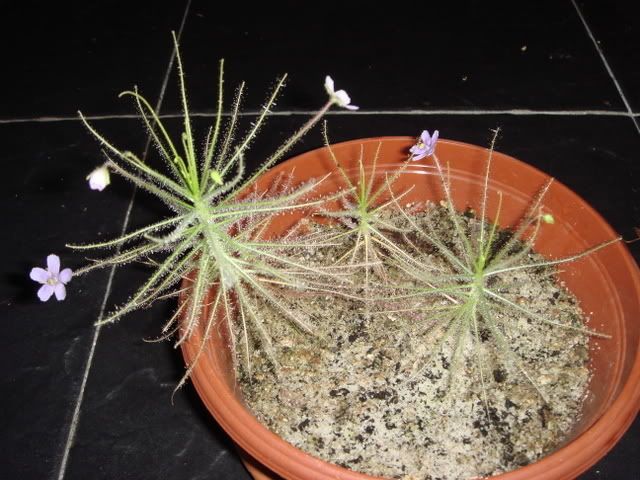 July'08 - A plant (seedling from one of the plants above) grown in soggy LFS. It was almost 1ft tall with branches at the top. The stem was really thick with the chopsticks as reference. (Photo 2) 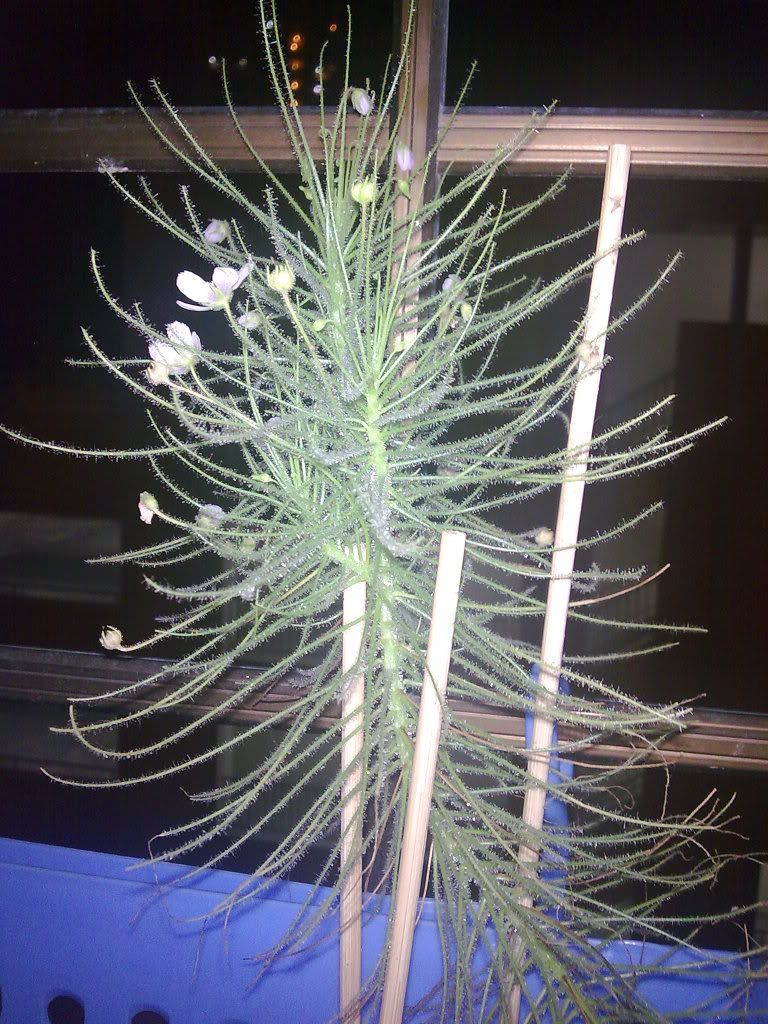 Aug'08 - Plants which are from the same batch of seeds as the "giant" B. liniflora grown in barely moist fine sand and peat. (Photo 3) 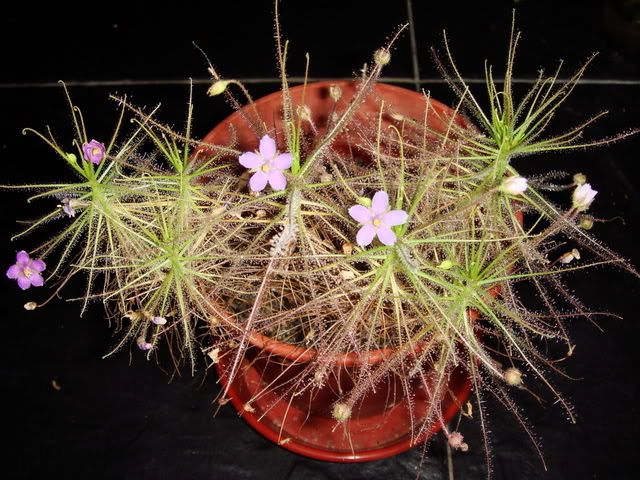 Aug'08 - B. liniflora tip cutting from one plant in Photo 3 which rooted in LSM. (Photo 4) 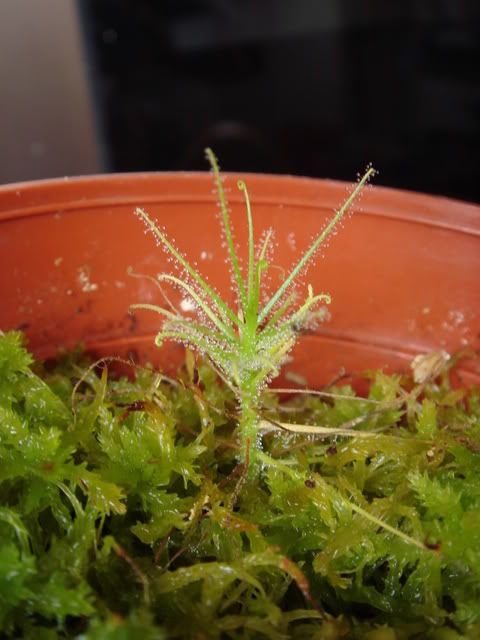 Aug'09 - Seedlings from the 'giant' B. liniflora in the second pic. These are currently growing in barely moist LFS and perlite. (Photo 5) 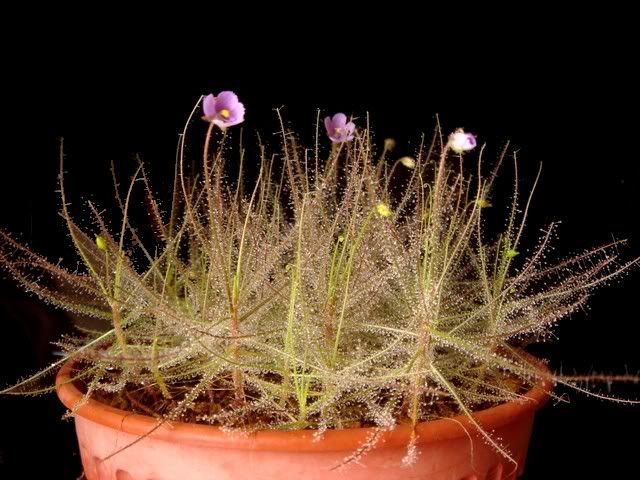 Flower on one of the plants in photo 5, not fully open. (Photo 6) 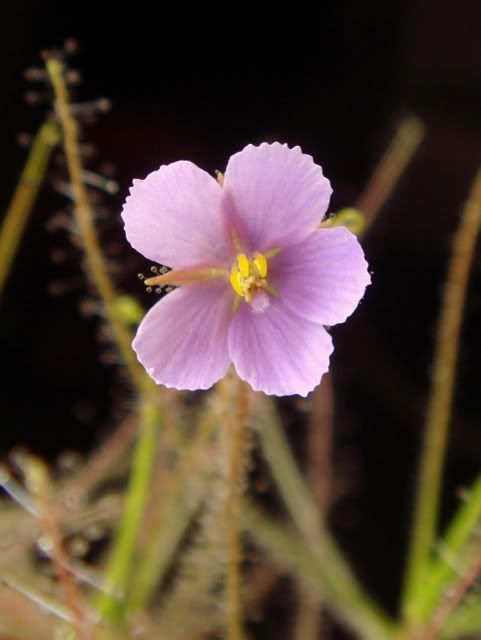 No pulvinus (Photo 7) 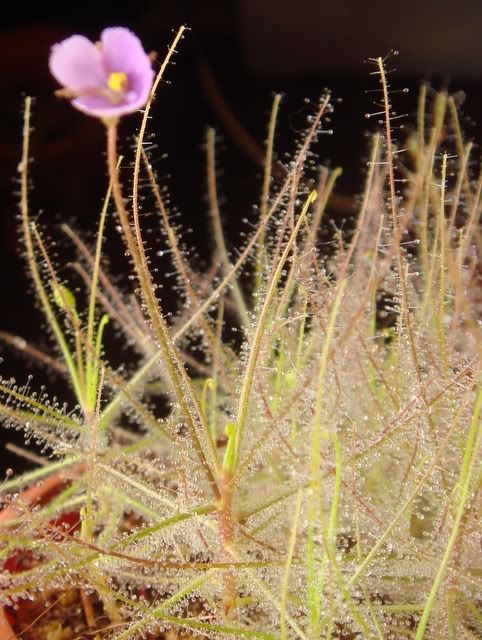 |
|
|
|
Post by Brian Barnes on Aug 10, 2009 10:00:38 GMT
Hello Cindy, Excellent photos indeed!  Thank you for your verification of my theory. This is blatant evidence that Byblis can take on different appearances depending on soil conditions i.e. extreme periods of wetness or dryness. I'm quite sure that based on our findings, these are applicable 'in situ' as well. Also, in the last photo that you've generously provided, one can see the clear swelling of tissue at the very base of the flower pedicel. This is evidence of the conditional pulvinus, that officially separates Byblis 'Goliath' or " Byblis spec. Goliath" from the rest of the supposed Byblis species in question. Unfortunately, Our good Byblis growing friends in Japan have never posted good closeup photos of their flower pedicel attachments at the main stem before and after pollination of the flowers, showing the ripening capsules. I doubt they ever will...  Of course, there's a reason for this. I'm quite sure you'd see pulvinus there as well.  Happy Growing, Brian. |
|
cindy
Full Member
Posts: 226
|
Post by cindy on Aug 11, 2009 10:17:57 GMT
Hi Brian,
What is conditional pulvinus? Does it mean that it is formed only on the pedicel and not on the leaves?
TIA
|
|
|
|
Post by Brian Barnes on Aug 11, 2009 15:25:49 GMT
Hi Cindy, Yes, Byblis 'Goliath' [filifolia] does have pulvini on the flower pedicels and the leaves as well. The pedicel pulvini are the most prominent though. Even if a flower is not pollinated successfully, the pedicel will still lower itself towards the ground via it's pulvinus.  I theorize that this pulvinic reaction, along with that of the leaves, create a tripod-like effect to help support the plant somewhat. However upon successful pollination, the formation of the pulvinic appendage is drastically enhanced and then lowers the ripening seed capsule towards the ground, to ensure proper seed set once the capsule dehices. ![]() bbproductions.smugmug.com/photos/616984867_8biru-M.jpg bbproductions.smugmug.com/photos/616984867_8biru-M.jpg[/img] The pulvini on the pedicels and leaves of Byblis 'Goliath' [filifolia] are remarkably similar to structures on the base of legume stems. For example, turgor pressure changes in the pulvinus of the “sensitive plant” (Mimosa pudica) is what causes that plant’s leaves to droop when disturbed. These same type structures is what causes the leaves and pedicels of Byblis 'Goliath' to move downwards. This is a very prominent and important feature never before documented within the genus Byblis as a whole, until the publication of B. 'Goliath' back in 2008. Happy Growing, Brian Barnes, 8/10/09 |
|
sweetpea
Full Member
MOLLIE RILSTONE
Posts: 163
|
Post by sweetpea on Aug 11, 2009 16:40:49 GMT
|
|
|
|
Post by Brian Barnes on Aug 11, 2009 17:01:53 GMT
Konnichiwa! Interesting point indeed.  And did you state what plant feature caused this movement in the specimens depicted in the prior CPN article as well? Surely the cause of such a reaction should have been quite noticeable and is as important as the prior documentation of such occurrences in the family Fabaceae. In my opinion, such movement is as important...and even more noticeable than snap- tentacle movement in Drosera. Also, some decent photographs of your entire plant as a whole, including the main stem/pedicel junction of your plants with ripening capsules might prove interesting indeed. Happy Growing,  Brian Barnes, 8/10/09 |
|
cindy
Full Member
Posts: 226
|
Post by cindy on Aug 12, 2009 11:50:25 GMT
I took some measurements a while ago. Pedicels: 4cm Leaves: 5cm Pedicels longer than leaves: no  But the anthers are significantly shorter than the filaments. |
|
|
|
Post by Brian Barnes on Aug 12, 2009 17:48:36 GMT
Hi Cindy, Great eye for observation!  I encourage all growers and lovers of Byblis to look closely at their plants [using the official species descriptions as a key] and publicly document their findings for the bettering of science as a whole. I look forward to their communications. Meanwhile, I'd like to share some of my latest findings in regards to the genus Byblis; Documentation of pulvinic formation on the leaves and pedicels of the supposed species Byblis liniflora, 8/11/09. Note the lowering capsule via pulvinic appendage, as is published in Byblis 'Goliath' [filifolia];  Happy Growing, Brian Barnes, 8/11/09. |
|
|
|
Post by picrophyll on Aug 17, 2009 14:56:29 GMT
|
|
cindy
Full Member
Posts: 226
|
Post by cindy on Aug 18, 2009 9:49:37 GMT
Phill, This is so off-topic...  ...but is B. aquatica all red in the wild? Or it is just the plants you saw? |
|
|
|
Post by gregallan on Aug 18, 2009 13:56:38 GMT
Cindy- great plants. I have noticed in the past that, in certain optimal conditions, B liniflora can be especially vigorous, like the spectaculat plants in your second photo.
Picrophyll- beautiful B aquatica photos. Although this characteristic does not appear on any official descriptions, all B aquatica plants I've seen- photos of plants in the wild, photos of plants in cultivation, and my own plants- have had very short tentacles. Maybe this is a significant feature?
Greg
|
|
cindy
Full Member
Posts: 226
|
Post by cindy on Aug 19, 2009 10:27:30 GMT
Greg,
Thanks for the compliments. B. liniflora does exceedingly well here so I do hope I have the conditions suitable for the other annual species. ;D
Phill,
I checked up on the info in "Glistening Carnivores", B. aquatica "typically produces foliage that is pure red in colour". Hehe.
|
|
jimscott
Full Member
Tropical Fish Enthusiast
Posts: 122
|
Post by jimscott on Oct 9, 2009 13:42:58 GMT
Mine doesn't compare, but:  |
|
|
|
Post by Brian Barnes on Oct 10, 2009 11:11:23 GMT
Hey Jim, Looking good!  You should have tons of seed soon by the looks of it if that is in fact Byblis liniflora, which should self-pollinate. In my opinion, your plant greatly favors Byblis filifolia, due to it's elongated internodes. Are you sure of it's ID? Have you gotten seed from it yet? Happy Growing, Brian. |
|







